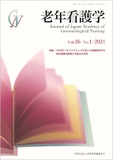Japanese
English
- 販売していません
- Abstract 文献概要
- 参考文献 Reference
抄録
中小規模病院の一般病床において,看護職が高齢者の身体拘束を開始するきっかけと判断理由を記述するため,中小規模病院3施設に勤務する看護職55人を対象に無記名自記式質問紙調査を行い,質的記述的分析を行った.
回答の得られた43人全員が高齢者の身体拘束の実施経験があった.身体拘束を開始するきっかけとして【インシデントにつながる症状や行動があった】【安全な行動変容が期待できなかった】【高齢者に対応できる人員が不足していた】が抽出された.また,判断理由として【インシデントの発生が予測された】【治療や生命の維持に危険を及ぼすことが予測された】【病棟全体の安全管理に配慮する必要があった】が抽出された.
高齢者に対する全人的理解とアセスメントの見直し,日ごろのケアのなかにある高齢者の倫理的問題について看護職同士が課題意識をもち,互いに指摘し合える環境の構築と教育体制の必要性が示唆された.
This study assessed opportunities and reasons for nursing professionals' judgment of when to begin physically restraining elderly patients in general beds at small and medium-sized hospitals. Anonymous self-administered questionnaire survey forms were received from 55 nurses working at three small and medium-sized hospitals. Data were analyzed qualitatively and descriptively.
All 43 respondents had applied physical restraint for elderly people. We extracted the following as opportunities for them to initiate physical restraint: [Symptoms or behaviors were inferred as leading to the incident.] [No expectation of safe behavior change.] [Too few personnel to accommodate elderly people.]. Furthermore, as reasons for judgment, the following were identified: [Incident occurrence was predicted.] [Risks to treatment and life support were predicted.] [Considerations of safety management were necessary for the entire ward.].
Results suggest the necessity for reviewing holistic understanding and assessment of elderly people, building nurse awareness of ethical issues related to daily care of elderly people, with building of mutually supportive systems for the environment and education.
Copyright © 2021, Japan Academy of Gerontological Nursing All rights reserved.


